The Role of Land Use Transition on Industrial Pollution Reduction in the Context of Innovation-Driven: The Case of 30 Provinces in China
Abstract
1. Introduction
2. Methodology
2.1. Spatial Weight Matrix
2.1.1. First-Order Contiguity Matrix
2.1.2. Geographical Distance Matrix
2.1.3. Another Matrix
2.2. Moran’s I Test
2.2.1. Global Moran’s I Test
2.2.2. Local Moran’s I Test
2.3. Description of Spatial Econometric Model
2.4. Entropy Method
3. Design of Variables and Models
3.1. Explained Variable
3.2. Explanatory Variables
3.2.1. Innovation Agglomeration
3.2.2. Human Capital Dimension
3.2.3. Material Capital Dimension
3.2.4. Urban Function Dimension
3.2.5. Government Dimension
3.3. Control Variables
3.4. Data Resource
3.5. Model Design
4. Results
4.1. Analysis of Spatial-Temporal Evolution
4.1.1. Industrial Pollution
4.1.2. Innovation Agglomeration
4.2. Spatial Regression Results
4.3. Robustness Tests
4.3.1. Spatial Autocorrelation Test
4.3.2. Model Applicability Test
5. Discussions
6. Conclusions
- (1)
- Both industrial pollution and innovation agglomeration have a clear spatial and temporal distribution. In eastern China, the level of industrial pollution is lower, while in northern China it is higher. Moreover, this distribution characteristic has become increasingly evident over time; innovation agglomeration is more extreme across China’s provinces—there are fewer regions of high agglomeration and more regions of medium and low agglomeration. Analysing the spatial distribution pattern, it is clear that innovation agglomeration is high in the eastern region and low in the western region. Moreover, this distribution characteristic has not changed significantly over time.
- (2)
- The land use transition towards an innovation-driven direction contributes to the reduction of industrial pollution emissions on the region but has no significant impact on the surrounding regions. In human capital dimension, full-time equivalent of R & D personnel plays the greatest role, followed by population density and finally average educational level; in material capital dimension, the role of internal expenditure of R & D funds is stronger than that of financial institutions density; in urban function dimension, the role of industrial structure evolution is significantly stronger than that of urban road area per capita, due to the high level of infrastructure development in China and the limited variation in urban road area per capita across regions; in government dimension, the role of proportion of technology expenditure is significantly stronger than that of green coverage for the same reasons as above.
- (3)
- In line with existing research, increasing per capita GDP and FDI and improving energy structure can help reduce industrial pollution. Moreover, increasing per capita GDP and improving energy structure can also generate positive spillover effects and promote the reduction of industrial pollution in neighbouring provinces.
- (1)
- Adhere to the policy of compulsory education, continue to strengthen the training of talents, improve the mechanism of training talents, and improve the treatment of talents, especially R & D personnel. For the eastern regions with a high degree of innovation agglomeration, various policies should be formulated for the introduction of talents to attract the inflow of more innovative talents.
- (2)
- Encourage and subsidise enterprises to undertake R & D; especially northern China, where the degree of innovation agglomeration is weak, should not be neglected because of its weak innovation agglomeration, but should instead be supported more vigorously, as these regions are heavily polluted by industry and their potential for improvement is enormous. Improve the distribution of financial institution outlets and ensure that a certain number of financial institutions are maintained throughout China to facilitate investment and financing for enterprises and to help them break down the barriers to financing.
- (3)
- Continue to improve supply-side reforms in order to promote the industrial structures. This is especially true for the more polluted regions of western and northern China. For the eastern regions, where pollution is low and the industrial structure is more advanced, there should be a targeted move towards demand-side reform. In addition, maintain or reduce the investment in road infrastructure, especially in the central and eastern regions, but infrastructure development in the western regions should be further strengthentened.
- (4)
- Strengthen financial support for science and technology research and development, and build a platform for cross-regional, cross-university and cross-disciplinary collaboration to increase the utilisation of research funds. At the same time, the government should continue to maintain the level of green coverage in all regions.
Author Contributions
Funding
Institutional Review Board Statement
Informed Consent Statement
Data Availability Statement
Conflicts of Interest
Appendix A
| Year | Urban Population Density | Average Educational Level | Full-Time Equivalent of R & D Personnel | Year | Urban Population Density | Average Educational Level | Full-Time Equivalent of R & D Personnel |
|---|---|---|---|---|---|---|---|
| 2018 | 0.311 | 0.295 | 0.394 | 2011 | 0.183 | 0.169 | 0.647 |
| 2017 | 0.285 | 0.288 | 0.428 | 2010 | 0.307 | 0.197 | 0.496 |
| 2016 | 0.175 | 0.160 | 0.665 | 2009 | 0.326 | 0.204 | 0.470 |
| 2015 | 0.458 | 0.222 | 0.320 | 2008 | 0.338 | 0.293 | 0.369 |
| 2014 | 0.364 | 0.219 | 0.417 | 2007 | 0.228 | 0.213 | 0.559 |
| 2013 | 0.177 | 0.152 | 0.670 | 2006 | 0.240 | 0.245 | 0.515 |
| 2012 | 0.389 | 0.307 | 0.304 |
| Year | Internal Expenditure of R & D Funds | Financial Institutions Density | Year | Internal Expenditure of R & D Funds | Financial Institutions Density |
|---|---|---|---|---|---|
| 2018 | 0.561 | 0.439 | 2011 | 0.644 | 0.356 |
| 2017 | 0.610 | 0.390 | 2010 | 0.531 | 0.469 |
| 2016 | 0.696 | 0.304 | 2009 | 0.695 | 0.305 |
| 2015 | 0.580 | 0.420 | 2008 | 0.770 | 0.230 |
| 2014 | 0.451 | 0.549 | 2007 | 0.508 | 0.492 |
| 2013 | 0.629 | 0.371 | 2006 | 0.595 | 0.405 |
| 2012 | 0.624 | 0.376 |
| Year | Industrial Structure Evolution | Urban Road Area Per Capita | Year | Industrial Structure Evolution | Urban Road Area Per Capita |
|---|---|---|---|---|---|
| 2018 | 0.680 | 0.320 | 2011 | 0.725 | 0.275 |
| 2017 | 0.715 | 0.285 | 2010 | 0.641 | 0.359 |
| 2016 | 0.737 | 0.263 | 2009 | 0.615 | 0.385 |
| 2015 | 0.771 | 0.229 | 2008 | 0.669 | 0.331 |
| 2014 | 0.800 | 0.200 | 2007 | 0.639 | 0.361 |
| 2013 | 0.777 | 0.223 | 2006 | 0.533 | 0.467 |
| 2012 | 0.748 | 0.252 |
| Year | Proportion of Technology Expenditure | Green Coverage | Year | Proportion of Technology Expenditure | Green Coverage |
|---|---|---|---|---|---|
| 2018 | 0.793 | 0.207 | 2011 | 0.767 | 0.233 |
| 2017 | 0.755 | 0.245 | 2010 | 0.865 | 0.135 |
| 2016 | 0.677 | 0.323 | 2009 | 0.743 | 0.257 |
| 2015 | 0.792 | 0.208 | 2008 | 0.660 | 0.340 |
| 2014 | 0.849 | 0.151 | 2007 | 0.854 | 0.146 |
| 2013 | 0.673 | 0.327 | 2006 | 0.750 | 0.250 |
| 2012 | 0.751 | 0.249 |
References
- Dolk, H.; Vrijheid, M. The impact of environmental pollution on congenital anomalies. Br. Med. Bull. 2003, 68, 25–45. [Google Scholar] [CrossRef]
- Grönqvist, H.; Nilsson, J.P.; Robling, P.-O. Understanding How Low Levels of Early Lead Exposure Affect Children’s Life Trajectories. J. Polit. Econ. 2020, 128, 3376–3433. [Google Scholar] [CrossRef]
- Juan, B.; Ana, C.; Jean-Paul, V.; Omer, C.; Muriel, C. Protected areas in the Atlantic facing the hazards of micro-plastic pollution: First diagnosis of three islands in the Canary Current. Mar. Pollut. Bull. 2014, 80, 302–311. [Google Scholar]
- Desforges, J.-P.W.; Galbraith, M.; Dangerfield, N.; Ross, P.S. Widespread distribution of microplastics in subsurface seawater in the NE Pacific Ocean. Mar. Pollut. Bull. 2014, 79, 94–99. [Google Scholar] [CrossRef]
- Evangeliou, N.; Grythe, H.; Klimont, Z.; Heyes, C.; Eckhardt, S.; Lopez-Aparicio, S.; Stohl, A. Atmospheric transport is a major pathway of microplastics to remote regions. Nat. Commun. 2020, 11, 1–11. [Google Scholar] [CrossRef]
- Olayinka, K.; Alo, B. Studies on Industrial Pollution in Nigeria: The effect of Textile effluents on the quality of Groundwater in some parts of Lagos. Niger. J. Health Biomed. Sci. 2004, 3, 44–50. [Google Scholar] [CrossRef]
- Lloyd, O.L.; Smith, G.; Lloyd, M.M.; Holland, Y.; Gailey, F. Raised mortality from lung cancer and high sex ratios of births associated with industrial pollution. Occup. Environ. Med. 1985, 42, 475–480. [Google Scholar] [CrossRef]
- Cameron, J.F. Radioisotope Techniques for Measurement and Control of Industrial Pollution. Meas. Control 1971, 4, 303–307. [Google Scholar] [CrossRef]
- Ebiefung, A.A.; Udo, G. An industrial pollution emission control model. Comput. Ind. Eng. 1999, 37, 371–374. [Google Scholar] [CrossRef]
- De Bruyn, S.; Bergh, J.V.D.; Opschoor, J. Economic growth and emissions: Reconsidering the empirical basis of environmental Kuznets curves. Ecol. Econ. 1998, 25, 161–175. [Google Scholar] [CrossRef]
- Glaeser, E.L.; Kahn, M.E. The greenness of cities: Carbon dioxide emissions and urban development. J. Urban Econ. 2010, 67, 404–418. [Google Scholar] [CrossRef]
- Cole, M.A. Trade, the pollution haven hypothesis and the environmental Kuznets curve: Examining the linkages. Ecol. Econ. 2004, 48, 71–81. [Google Scholar] [CrossRef]
- Managi, S.; Hibiki, A.; Tsurumi, T. Does trade openness improve environmental quality? J. Environ. Econ. Manag. 2009, 58, 346–363. [Google Scholar] [CrossRef]
- Ozturk, I.; Acaravci, A. The long-run and causal analysis of energy, growth, openness and financial development on carbon emissions in Turkey. Energy Econ. 2013, 36, 262–267. [Google Scholar] [CrossRef]
- Su, Y.; Yu, Y.-Q. Spatial agglomeration of new energy industries on the performance of regional pollution control through spatial econometric analysis. Sci. Total Environ. 2020, 704, 135261. [Google Scholar] [CrossRef]
- Zeng, D.Z.; Zhao, L. Pollution havens and industrial agglomeration. J. Environ. Econ. Manag. 2009, 58, 141–153. [Google Scholar] [CrossRef]
- Han, L.; Kung, J.K.S. Fiscal incentives and policy choices of local governments: Evidence from China. J. Dev. Econ. 2015, 116, 89–104. [Google Scholar] [CrossRef]
- Dean, J.M.; Lovely, M.E.; Wang, H. Are foreign investors attracted to weak environmental regulations? Evaluating the evidence from China. J. Dev. Econ. 2009, 90, 1–13. [Google Scholar] [CrossRef]
- Zhu, C.; Lee, C.-C. The internal and external effects of air pollution on innovation in China. Environ. Sci. Pollut. Res. 2021, 28, 9462–9474. [Google Scholar] [CrossRef]
- Ahn, S.J.; Yoon, H.Y. ‘Green chasm’ in clean-tech for air pollution: Patent evidence of a long innovation cycle and a technological level gap. J. Clean. Prod. 2020, 272, 122726. [Google Scholar] [CrossRef]
- Omri, A.; Hadj, T.B. Foreign investment and air pollution: Do good governance and technological innovation matter? Environ. Res. 2020, 185, 109469. [Google Scholar] [CrossRef] [PubMed]
- Ghosh, S. Examining carbon emissions economic growth nexus for India: A multivariate cointegration approach. Energy Policy 2010, 38, 3008–3014. [Google Scholar] [CrossRef]
- Brunnermeier, S.B.; A Cohen, M. Determinants of environmental innovation in US manufacturing industries. J. Environ. Econ. Manag. 2003, 45, 278–293. [Google Scholar] [CrossRef]
- Schumpeter, J.; Backhaus, U. The Theory of Economic Development; Springer: Boston, MA, USA, 2006; pp. 61–116. [Google Scholar]
- Taylor, M.S.; Copeland, B.R. Trade, Growth and the Environment; NBER Working Paper; National Bureau of Economic Research: Cambridge, MA, USA, 2003; p. 9823. [Google Scholar]
- Ji, X.; Wang, K.; Ji, T.; Zhang, Y.; Wang, K. Coupling Analysis of Urban Land Use Benefits: A Case Study of Xiamen City. Land 2020, 9, 155. [Google Scholar] [CrossRef]
- Ji, Z.H.; Zhang, P. Spatial Difference and Driving Mechanism of Urban Land Use Efficiency Under the Environmental Constraints: Based on 285 Cities in China. China Land Sci. 2020, 34, 72–79. [Google Scholar] [CrossRef]
- Huang, J.; Xue, D. Study on Temporal and Spatial Variation Characteristics and Influencing Factors of Land Use Efficiency in Xi’an, China. Sustainability 2019, 11, 6649. [Google Scholar] [CrossRef]
- Yu, J.; Zhou, K.; Yang, S. Land use efficiency and influencing factors of urban agglomerations in China. Land Use Policy 2019, 88. [Google Scholar] [CrossRef]
- Li, J.; Lewis, J.; Rowland, J.; Tappan, G.; Tieszen, L. Evaluation of land performance in Senegal using multi-temporal NDVI and rainfall series. J. Arid. Environ. 2004, 59, 463–480. [Google Scholar] [CrossRef]
- Chen, C.-L. Establishing Urban Industrial Parks to Drive Regional Innovation System. Int. J. Autom. Smart Technol. 2012, 2, 283–286. [Google Scholar] [CrossRef]
- Yun, W.; Zhu, D.; Tang, H. Reshaping and innovation of China land consolidation strategy. Trans. Chin. Soc. Agric. Eng. 2016, 32, 1–8. [Google Scholar]
- Anselin, L. Spatial Effects in Econometric Practice in Environmental and Resource Economics. Am. J. Agric. Econ. 2001, 83, 705–710. [Google Scholar] [CrossRef]
- Yu, X.; Shen, M.; Shen, W.; Zhang, X. Effects of Land Urbanization on Smog Pollution in China: Estimation of Spatial Autoregressive Panel Data Models. Land 2020, 9, 337. [Google Scholar] [CrossRef]
- Romer, P.M. Increasing Returns and Long-Run Growth. J. Polit. Econ. 1986, 94, 1002–1037. [Google Scholar] [CrossRef]
- Romer, P. Endogenous Technological Change. J. Polit. Econ. 1989, 98, 71–102. [Google Scholar] [CrossRef]
- Motlagh, Z.K.; Lotfi, A.; Pourmanafi, S.; Ahmadizadeh, S.; Soffianian, A. Spatial modeling of land-use change in a rapidly urbanizing landscape in central Iran: Integration of remote sensing, CA-Markov, and landscape metrics. Environ. Monit. Assess. 2020, 192, 1–19. [Google Scholar] [CrossRef] [PubMed]
- Tian, F.; Li, M.; Han, X.; Liu, H.; Mo, B. A Production–Living–Ecological Space Model for Land-Use Optimisation: A case study of the core Tumen River region in China. Ecol. Model. 2020, 437, 109310. [Google Scholar] [CrossRef]
- Bottazzi, L.; Peri, G. Innovation and spillovers in regions: Evidence from European patent data. Eur. Econ. Rev. 2003, 47, 687–710. [Google Scholar] [CrossRef]
- Tobler, W.R. A Computer Movie Simulating Urban Growth in the Detroit Region. Econ. Geogr. 1970, 46, 234. [Google Scholar] [CrossRef]
- Jaffe, A.B. Real effects of academic research. Am. Econ. Rev. 1989, 46, 957–970. [Google Scholar]
- Xu, D.; Shenkar, O. Note: Institutional Distance and the Multinational Enterprise. Acad. Manag. Rev. 2002, 27, 608–618. [Google Scholar] [CrossRef][Green Version]
- Conley, T.G.; Topa, G. Socio-economic distance and spatial patterns in unemployment. J. Appl. Econ. 2002, 17, 303–327. [Google Scholar] [CrossRef]
- Pianta, M.; Archibugi, D. Innovation Surveys and Patents as Technology Indicators: The State of the Art. 1996. Available online: https://www.irpps.cnr.it/pubblicazioni/innovation-surveys-and-patents-as-technology-indicators-the-state-of-the-art/ (accessed on 22 March 2021).
- Wang, L.M.; Wang, N. The Interactive Effects of Talent Agglomeration, Technological Innovation and High-quality Economic Growth: Empirical Analysis of VAR Model based on Provincial Panel Data. J. Henan Norm. Univ. 2021, 48, 88–94. [Google Scholar] [CrossRef]
- Alberti, M. The Effects of Urban Patterns on Ecosystem Function. Int. Reg. Sci. Rev. 2005, 28, 168–192. [Google Scholar] [CrossRef]
- Kuznets, S. Quantitative Aspects of the Economic Growth of Nations: II. Industrial Distribution of National Product and Labor Force. Econ. Dev. Cult. Chang. 1957, 5, 1–111. [Google Scholar] [CrossRef]
- Kuznets, S. Modern economic growth: Findings and reflections. Am. Econ. Rev. 1973, 63, 247–258. [Google Scholar]
- Zhang, S.G. Promoting financial reform and adjusting monetary policy in accordance with the requirements of Marketization. J. Financ. 1996, 5, 8–10. [Google Scholar]
- Taylor, C.; Pollard, S.; Angus, A.; Rocks, S. Better by design: Rethinking interventions for better environmental regulation. Sci. Total Environ. 2013, 447, 488–499. [Google Scholar] [CrossRef]
- Jorgenson, A.K. Foreign direct investment and the environment, the mitigating influence of institutional and civil society factors, and relationships between industrial pollution and human health: A panel study of less-developed countries. Organ. Environ. 2009, 22, 135–157. [Google Scholar] [CrossRef]
- Wang, L.P.; Li, T.T.; Hu, Y.W. Economic Growth, Energy Structure and Industrial Pollution—Empirical Analysis Based on Spatial Panel Metering. J. Ind. Technol. Econ. 2016, 8, 3–11. [Google Scholar]
- Mundlak, Y. On the Pooling of Time Series and Cross Section Data. Econom. J. Econom. Soc. 1978, 46, 69. [Google Scholar] [CrossRef]
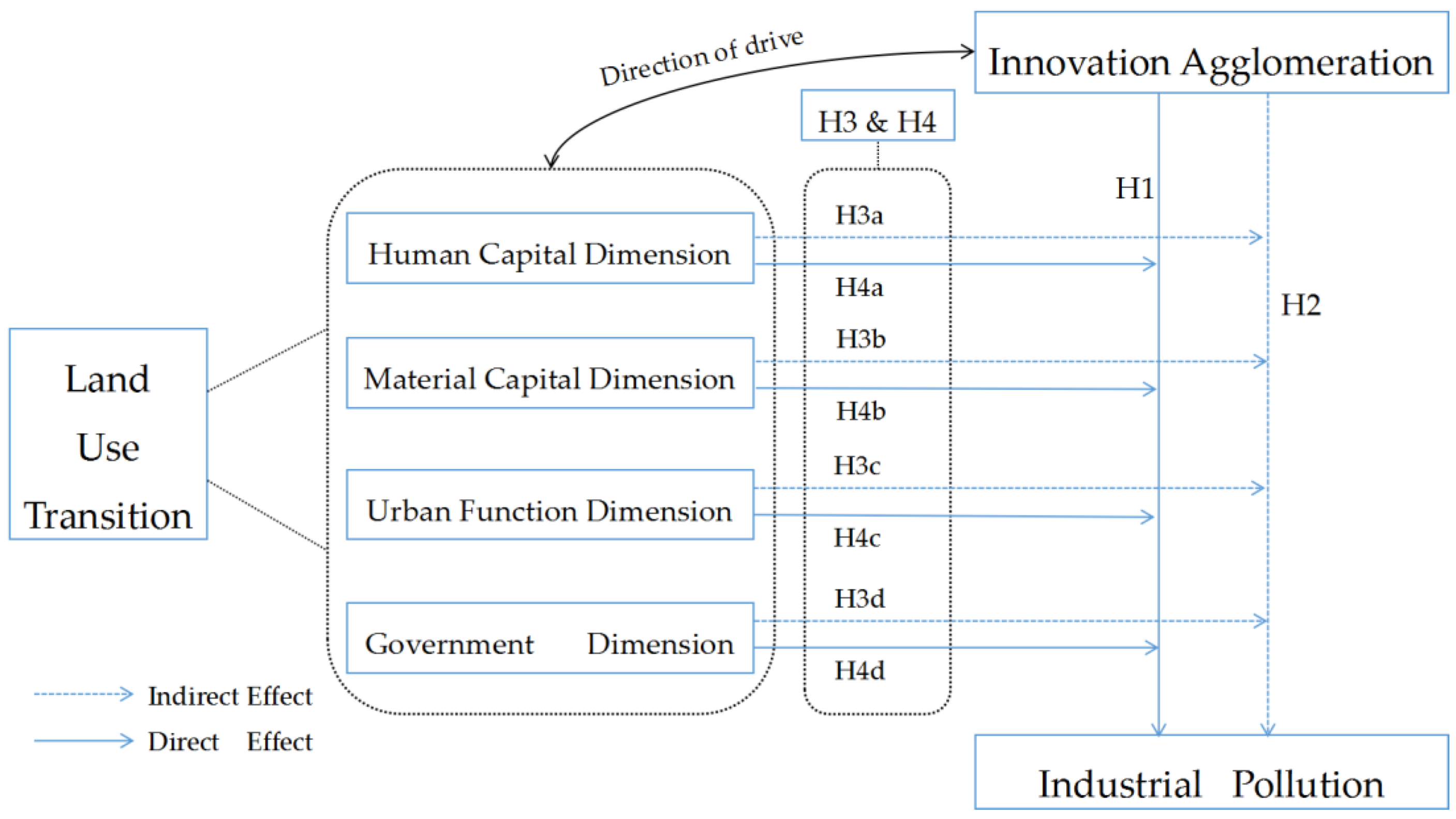
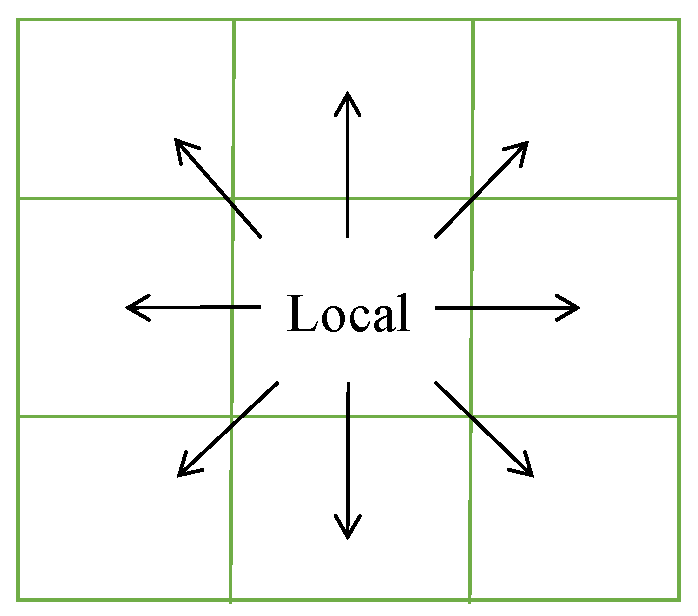
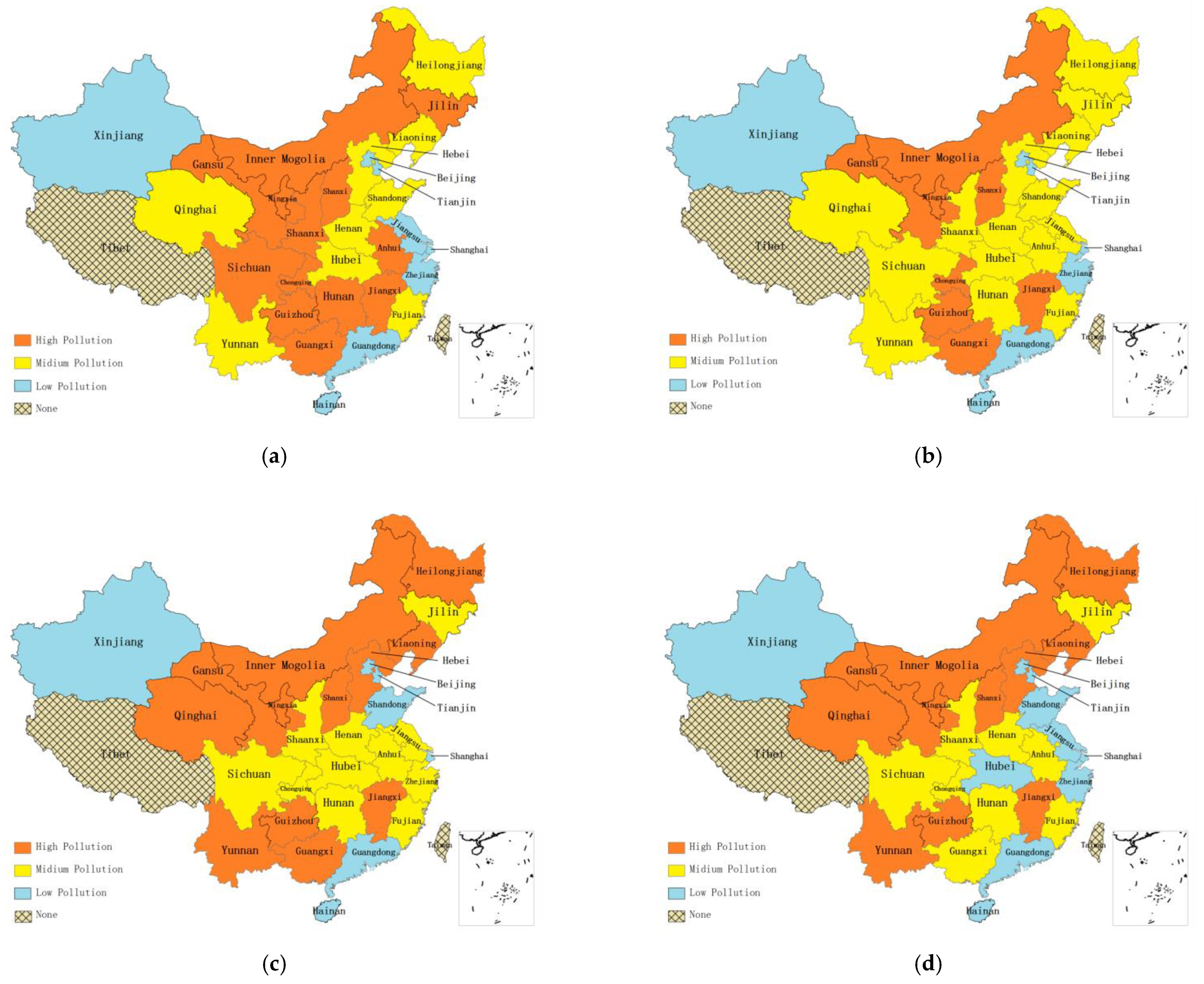
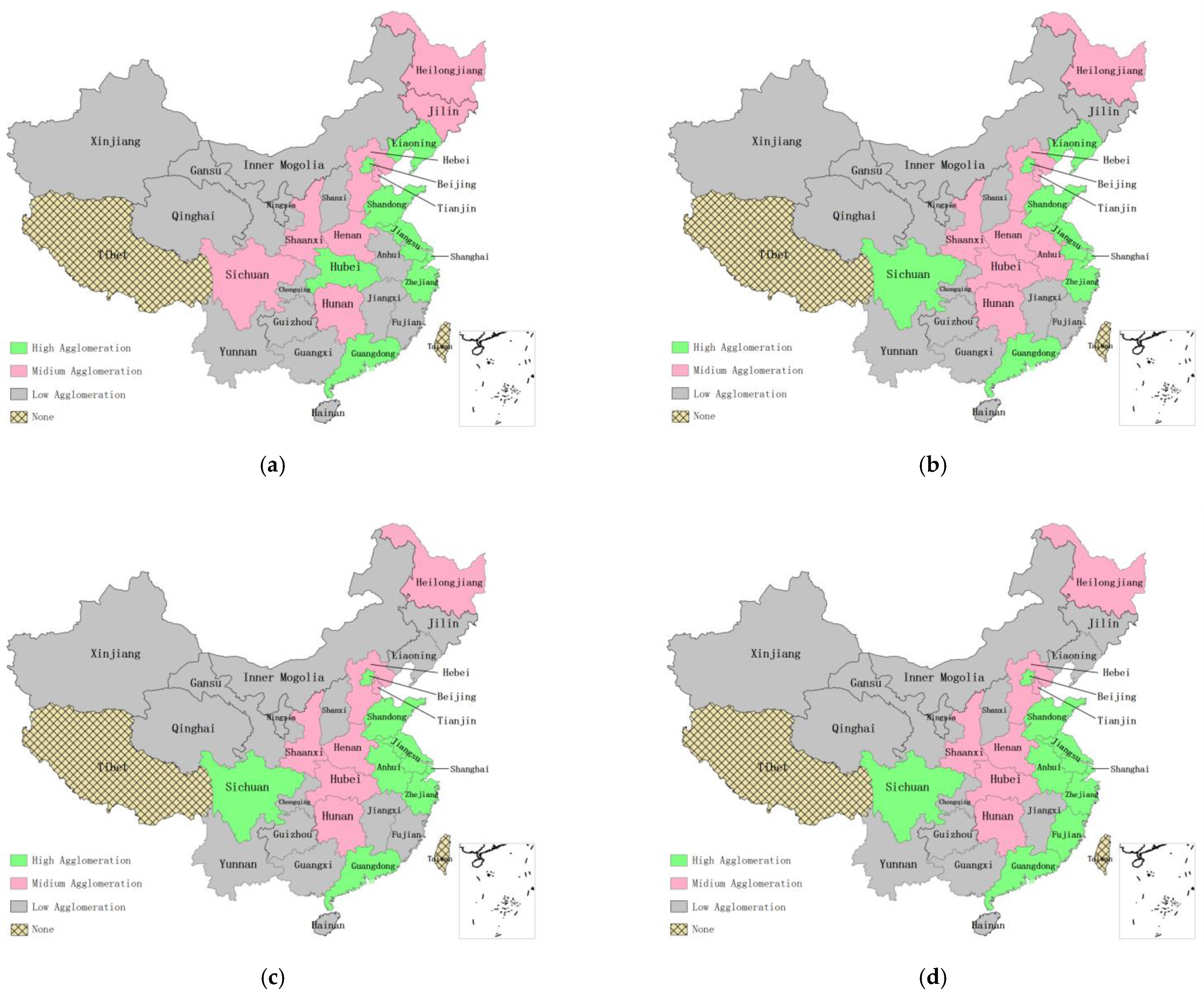
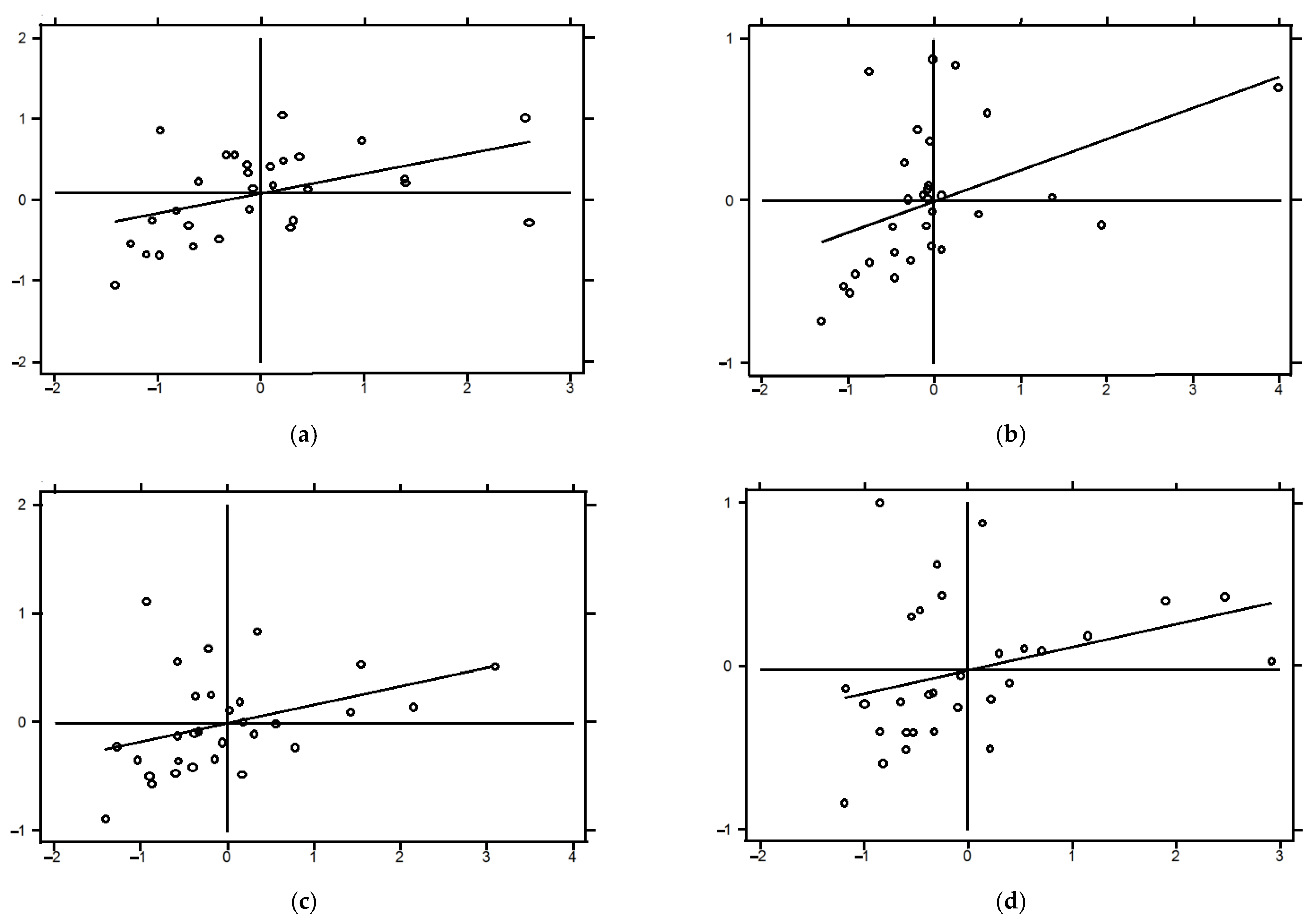
| Type | Variable | Unit | Obs | Mean | Std. | Label |
|---|---|---|---|---|---|---|
| Explained variable | Industrial pollution | - | 390 | 4.4162 | 0.7752 | Ind_pol |
| Moderate variable | Innovation agglomeration | item | 390 | 9.0124 | 1.5499 | Inno_agg |
| Explanatory variables (Human capital dimension) | Urban population density | person/km2 | 390 | 7.8374 | 0.4484 | Human |
| Average educational level | year/person | 390 | 2.1703 | 0.1067 | ||
| Full-time equivalent of R & D personnel | 10,000 man-year | 390 | 10.9526 | 1.1148 | ||
| Explanatory variables (Material capital dimension) | Internal expenditure of R & D funds | 10,000 yuan | 390 | 14.1989 | 1.4054 | Material |
| Financial institutions density | Unit/km2 | 390 | −5.6902 | 0.4764 | ||
| Explanatory variables (Urban function dimension) | Industrial Structure Evolution | % | 390 | 3.7468 | 0.1932 | Urban |
| Urban road area per capita | m2/person | 390 | 2.5838 | 0.3305 | ||
| Explanatory variables (Government dimension) | Proportion of technology expenditure | % | 390 | −1.0851 | 0.4764 | Government |
| Green coverage | % | 390 | 3.6197 | 0.1338 | ||
| Control variables | Per capita GDP | yuan/person | 390 | 10.4694 | 0.5826 | Per_GDP |
| Foreign direct investment | 10,000 dollar | 390 | 12.5964 | 1.6338 | FDI | |
| Energy structure | % | 390 | 2.6562 | 0.4717 | Ener_stru |
| Explanatory Variables | I | II | III | IV | V |
|---|---|---|---|---|---|
| Inno_agg | −0.2315 ** | −0.3096 ** | −0.2340 * | −0.2214 * | −0.2193 * |
| Human | 0.0655 *** | - | - | - | - |
| Material | −0.1296 ** | - | - | - | - |
| Urban | 0.0264 | - | - | - | - |
| Government | 0.0828 ** | - | - | - | - |
| Inno_agg * Human | - | −0.0627 *** | - | - | - |
| Inno_agg * Material | - | - | −0.0152 * | - | - |
| Inno_agg * Urban | - | - | - | −0.0018 * | - |
| Inno_agg * Government | - | - | - | - | −0.0104 * |
| Per_GDP | −0.4558 * | −0.4325 * | −0.4865 * | −0.4871 * | −0.4903 * |
| FDI | −0.1439 * | −0.1374 * | −0.1341 * | −0.1329 * | −0.1309 * |
| Ener_stru | −0.3496 * | −0.3658 * | −0.3709 * | −0.3784 * | −0.3693 * |
| W * Inno_agg | 0.2287 | 0.1623 | 0.1853 | 0.2215 | 0.2171 |
| W * Human | 0.0424 | - | - | - | - |
| W * Material | 0.0076 | - | - | - | - |
| W * Urban | 0.0248 | - | - | - | - |
| W * Government | −0.0382 | - | - | - | - |
| W * Inno_agg * Human | - | −0.0403 | - | - | - |
| W * Inno_agg * Material | - | - | −0.0390 | - | - |
| W * Inno_agg * Urban | - | - | - | 0.0185 | - |
| W * Inno_agg * Government | - | - | - | - | −0.0145 |
| W * Per_GDP | −0.6703 ** | −0.7312 ** | −0.7095 ** | −0.7450 ** | −0.7369 * |
| W * FDI | 0.1292 | 0.1382 | 0.1372 | 0.1531 | 0.1467 |
| W * Ener_stru | −0.8653 ** | −0.8275 ** | −0.8191 ** | −0.8171 ** | −0.8204 ** |
| R-square | 0.2320 | 0.2611 | 0.2625 | 0.2509 | 0.2594 |
| Log-L | 53.6512 | 48.3867 | 45.2893 | 44.0831 | 44.2472 |
| rho | −2.51 ** | −2,24 ** | −2.35 ** | −2.25 ** | −2.32 ** |
| Year | Moran’s I | p-Value | Year | Moran’s I | p-Value |
|---|---|---|---|---|---|
| 2006 | 2.356 | 0.018 | 2013 | 1.192 | 0.117 |
| 2007 | 2.451 | 0.014 | 2014 | 1.762 | 0.078 |
| 2008 | 2.317 | 0.021 | 2015 | 1.690 | 0.091 |
| 2009 | 2.316 | 0.021 | 2016 | 1.794 | 0.073 |
| 2010 | 2.205 | 0.027 | 2017 | 1.624 | 0.096 |
| 2011 | 2.992 | 0.003 | 2018 | 1.523 | 0.128 |
| 2012 | 1.687 | 0.090 |
| I | II | III | IV | V | |
|---|---|---|---|---|---|
| Spatial fixed effect | 115.86 *** | 121.47 *** | 120.71 *** | 126.13 *** | 119.75 *** |
| Time-period fixed effect | 22.55 *** | 36.54 *** | 35.92 *** | 37.86 *** | 34.89 *** |
Publisher’s Note: MDPI stays neutral with regard to jurisdictional claims in published maps and institutional affiliations. |
© 2021 by the authors. Licensee MDPI, Basel, Switzerland. This article is an open access article distributed under the terms and conditions of the Creative Commons Attribution (CC BY) license (http://creativecommons.org/licenses/by/4.0/).
Share and Cite
Meng, Y.; Wang, K.; Lin, Y. The Role of Land Use Transition on Industrial Pollution Reduction in the Context of Innovation-Driven: The Case of 30 Provinces in China. Land 2021, 10, 353. https://doi.org/10.3390/land10040353
Meng Y, Wang K, Lin Y. The Role of Land Use Transition on Industrial Pollution Reduction in the Context of Innovation-Driven: The Case of 30 Provinces in China. Land. 2021; 10(4):353. https://doi.org/10.3390/land10040353
Chicago/Turabian StyleMeng, Yanjun, Kun Wang, and Yuanyuan Lin. 2021. "The Role of Land Use Transition on Industrial Pollution Reduction in the Context of Innovation-Driven: The Case of 30 Provinces in China" Land 10, no. 4: 353. https://doi.org/10.3390/land10040353
APA StyleMeng, Y., Wang, K., & Lin, Y. (2021). The Role of Land Use Transition on Industrial Pollution Reduction in the Context of Innovation-Driven: The Case of 30 Provinces in China. Land, 10(4), 353. https://doi.org/10.3390/land10040353







